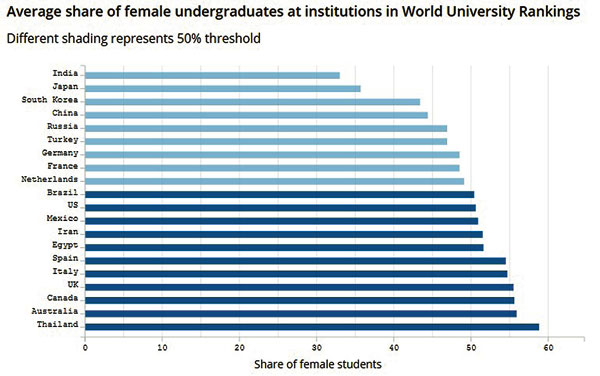India student gender gap at top universities ‘highest in world’
View(s):India needs to do much more to encourage and support women who want to pursue an academic or scientific career if it wants to improve the gender balance in its top universities, experts have said.
 It comes after “THE” data showed that the country has the lowest average female student ratio among nations with at least 10 institutions in the World University Rankings.
It comes after “THE” data showed that the country has the lowest average female student ratio among nations with at least 10 institutions in the World University Rankings.
On average, just a third of undergraduates at ranked Indian institutions are women and India is one of only four nations where the average proportion of female students at top universities is fewer than 45 per cent. The others are Japan (36 per cent), South Korea (43 per cent) and China (44 per cent).
Data from the United Nations suggest that India has increased its general enrolment rate for women in higher education in recent years; the share of women in all tertiary programmes was 48.1 per cent in 2017, up from 45.9 per cent in 2013. However, at doctoral level, progress has been slower, with the share of female enrolments at 42.1 per cent in 2017 compared with 41.8 per cent in 2013, according to United Nations Educational, Scientific and Cultural Organisation figures.
The figures for ranked universities – which include many science-focused universities such as the Indian Institutes of Technology – and PhD students suggest that the increase in female participation may be skewed towards certain fields and types of institution.
Kristen Renn, professor of higher, adult and lifelong learning at Michigan State University, and author of the 2014 book Women’s Colleges and Universities in a Global Context, said that some of the overall change could be because of a growing number of places at women-only institutions and rural colleges.
To increase enrolments at the highest ranked institutions would require measures such as “supporting female secondary [school] students’ interest and talent in engineering and technology” given that these were the fields that were well below gender parity.
Professor Renn added that if more women took graduate degrees and went into professorships at top-ranked universities it could also have a knock-on effect by providing “more role models and mentors for undergraduates in these fields”.
Antara Sengupta, a research fellow specialising in higher education at the Observer Research Foundation, a thinktank based in India, said that true gender parity would take time “given the prevailing culture of a patriarchal society where women are considered secondary citizens in several parts of the country”.
“The problem is rooted in the Indian school system itself as most girl students drop out in the adolescent stages – that is, in senior secondary levels. There have to be sensitisation programmes for women in science and such fields to educate them and their families about future possibilities of academic and professional careers.”
She added that places could also be reserved specifically for women in higher education, including at doctoral and postdoctoral level.
Professor Renn also said such a move could be a solution, but warned that it may be a “blunt instrument” that might be “extremely difficult to accomplish” given “there are millions of secondary students, male and female, for whom there are no seats in tertiary education”.
- Courtesy-S.Baker -THE



